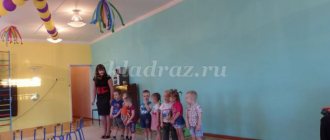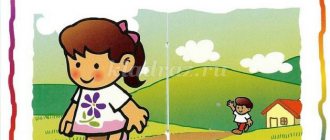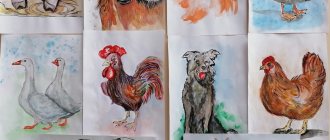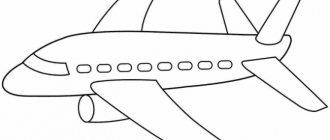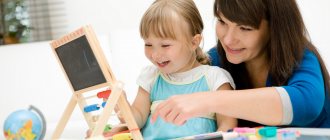Visiting the hedgehogs. Lesson notes for the second junior group
Summary of a complex lesson in the second junior group “Visiting the Hedgehogs”
Educational objectives:
Continue to teach children to independently compose a set, highlighting each individual element in it, name the general sign of quantity, use the words “many”, “one” in speech, coordinating them with nouns in gender, number and case.
Exercise children in grouping objects by size and color. Practice spatial orientation away from you (vertical and frontal direction). Improve the ability to display in speech using prepositions (on, under, for, in, etc.) the location of things. Developmental tasks:
To develop thinking, the ability to generalize, and classify.
Develop gross and fine motor skills, tactile perception. Educational objectives:
To develop a caring attitude towards animals.
Preliminary preparation:
learning poetry.
Equipment and materials:
soft toy hedgehog (without spines);
hedgehog toys - 6 pieces; There are clothespins in the tray according to the number of children; paper leaves of 2 sizes; toys: fox, wolf, bear; Christmas trees, trees, stumps; cloth bag; small toys - mushrooms, basket, treats for children. Methodological techniques:
demonstration, examination of the subject, use of clarity, surprise moment, teacher’s explanation, conversation, artistic expression, questions, game, children’s exercises, game situation, individual work, analysis.
Progress of the lesson
Educator: Hello, children. How beautiful and elegant you are today. Look, we have guests today. Say hello to them. Everyone look at them. We looked. Well done! Now listen to me carefully. Today we will go for a walk in the forest. And this forest is not ordinary, but fabulous. Do you want to get into a fairy forest? To do this, we need to stand one after another, try to move together and listen carefully. Line up, children. Everyone is ready. Then let's go. Children line up in a column and walk to the accompaniment of music. Educator: The legs walked: stomp, stomp, stomp, Straight along the path: stomp, stomp, stomp, Come on, it’s more fun: stomp, stomp, stomp, That’s how we do it: stomp, stomp, stomp. The legs ran along the flat path, They ran away, they ran away, Only their heels sparkled. The children end up in the forest. Educator: Well, here we are in the forest. Look how beautiful it is here. Hello forest, dense forest, full of fairy tales and miracles. What is hidden in your wilderness? What's going on with the trees? Open everything, don’t hide it: You see, we are our own. Educator: Children, what time of year is it now? Children: Autumn! Educator: This is a very beautiful time. Despite the fact that it is getting cooler, a cold wind often blows, the sun shines less and less often and often hides behind the clouds, and it rains more often. Trees and bushes become multi-colored - it is the leaves on them that change color. Please look and tell me what color the leaves on the trees are? Children: Yellow, red, green. Educator: It’s quiet in the autumn forest, you can only hear the leaves rustling under your feet. Let's walk through the autumn carpet of leaves and listen to how they rustle. (Children walk on a carpet of autumn leaves, accompanied by the rustling of autumn leaves) Educator: Now we will collect these leaves and start dancing. I will take yellow leaves, girls will take red leaves, and boys will take green ones. (Children collect leaves and perform a dance, then sit on chairs). Educator: It’s so beautiful in the autumn forest! Guys, let's tell poems about autumn. (Children recite poems about autumn)
If the leaves on the trees have turned yellow, If the birds have flown to a distant land, If the sky is gloomy, if the rain is pouring, This time of year is called autumn. Leaf fall, leaf fall, Yellow leaves are flying. Yellow maple, yellow beech, Yellow circle of the sun in the sky. Yellow yard, yellow house. The whole earth is yellow all around. Yellowness, yellowness, So autumn is not spring. Here is a maple leaf on a branch. Now it's just like new! All ruddy and golden. Where are you going, leaf? Wait! Autumn is walking in our park, Autumn gives gifts to everyone: Red beads - Rowan, Pink apron - Aspen, Yellow umbrella - Poplars, Autumn Gives fruits to us. Autumn, autumn, don’t rush, And wait for the rains. Give us more summer, sunshine and light. Autumn has come, our garden has turned yellow. The leaves on the birch tree are burning golden. Do not hear the cheerful Songs of the nightingale. The birds flew away to distant lands.
Fizminutka
on the carpet “Autumn” Autumn leaves are quietly spinning, (spinning on tiptoes, arms to the sides) The leaves are quietly lying under our feet (crouching) And rustling and rustling under our feet, (moving hands along the floor to the right and left) As if they want to spin again. (rise, spin)
Educator: Tell me, children, what animals live in the forest? Children answer, make assumptions, name the forest inhabitants and find a fox, a squirrel, a bunny, a bear in a forest clearing. Educator: That's right, children! And who is that hiding behind the stump? So it's a hedgehog! The teacher shows the children a toy - a hedgehog. Guys, the hedgehog says hello to you and you say hello to him. Children, pet the hedgehog! The teacher gives the children the opportunity to stroke. Children, look at the hedgehog. What doesn't he have? (thorns) Hedgehog, where are your thorns? Oh, guys, the hedgehog told me that he forgot them at home. Let's help the hedgehog get the spines back on his back? Imagine that these clothespins are thorns. Take each one one clothespin - a thorn and attach them to the hedgehog's back. Children complete the task. Educator: Katya, how many thorns did you attach to the hedgehog’s back? (one thorn) And you, Vova, how many clothespins and thorns did you attach? One too. Well done, children. That's right, each of you attached only one thorn. How many of them does the hedgehog have on his back? (lots of thorns). That's right, children, the hedgehog has a lot of thorns. Pat the hedgehog on the back. What has he become? (prickly) Educator: Why are you such a prickly hedgehog? This is me just in case! Do you know who my neighbors are? Foxes, wolves and bears! Educator: Children, why does a hedgehog need needles? Children: To protect yourself from enemies. Educator: Children, do you know how a hedgehog defends itself from enemies? (children's answers). He curls up into a ball, hides his nose, and there are needles at the top that protect him. Like this (show on a toy). I suggest you play. Now you will put on masks and turn into hedgehogs. Here you are, hedgehogs. Now you will run around the hall to the music, and when a fox or bear appears, you will have to stop and quickly curl up into a ball (group and sit motionless). The fox has left, the hedgehogs are walking again. The game is repeated 2 - 3 times. Educator: Well done, hedgehogs, they played well. You sat so quietly that neither the fox nor the bear noticed you. Now let's take off our masks and turn into children and hit the road with the hedgehog. Look, children, a magic tree has grown in our fairy-tale forest. Look how many leaves fell from it! There must have been a strong wind and they were blown off the tree. And the hedgehog really likes to collect leaves, he likes order in the forest. Let's help the hedgehog assemble a beautiful carpet from leaves. Look, under the tree there are leaves of different sizes and different colors. And in the clearing the windows are also of different sizes. And you need to find its own window for each leaf (children collect the carpet). The teacher carries out individual work to fix the size and color of the leaves. Educator: What size is your leaf? What color is it? Educator: Look, children, what a beautiful carpet you have made. And the hedgehog whispers to me that he also liked the carpet. It turned out bright and beautiful. Well done boys! Finger gymnastics “Autumn” by N. Nishchev: The wind flew through the forest, (Smooth, wave-like movements of the palms). The wind counted the leaves: (They bend one finger on both hands) Here is an oak one, Here is a maple one, Here is a carved rowan tree, Here is a golden one from a birch tree. Here is the last leaf from the aspen tree The wind threw it onto the path. (Place palms on knees.)
Educator: Hedgehog, why are you suddenly sad? (listens to the hedgehog) Hedgehog: I walked towards him with my friends, and they ran away along the road and hid from me! Educator: Guys, let's help the hedgehog find his friends? Children look around the hall for hedgehogs, and, having found them, bring them to the teacher. The teacher asks each child: “Where was the hedgehog hiding?” (on a stump, behind a stump, under a Christmas tree, behind a tree, in a hole, etc.) Each child takes the hedgehog and carries it to the clearing. Educator: Let's, children, put the hedgehogs on a beautiful carpet. The teacher quietly attaches a wonderful bag to the hedgehog. The teacher picks up the hedgehog, who has a wonderful bag on his back, and sings 1 verse of the song “Little Hedgehog”: Little hedgehog, four legs, carries a bag on his back, sings the song. Tufti-tufti-tufti - that I am the strongest in the forest! I am the strongest in the forest! Tufti-tufti-tufti - tufti-tufti-tufti. Educator: Hedgehog, what is this pouch on your back? (wonderful) What do you have in your bag? The hedgehog speaks quietly into the teacher's ear. The teacher listens. Educator: The hedgehog tells me that he collected mushrooms for his hedgehog friends. Do you want to see which ones? The teacher takes out several small blocks and mushrooms and shows them to the children. Educator: Oh, hedgehog, you have not only mushrooms here, but also leaves! Places the items back into the bag. Now the guys and I will only get the mushrooms and put them in a basket. Educator: Find a fungus for the hedgehog. Children take turns putting their hand into the bag and looking for the fungus among other toys and putting it in the basket. Kolya, how many mushrooms did you get? The children say that they got one mushroom, two mushrooms. Educator: Children, how many mushrooms are there in the basket? (lots of mushrooms) Let's, children, take the mushrooms to the hedgehogs and treat them. The teacher puts a basket of mushrooms in front of the hedgehogs and says: Help yourself, hedgehogs! Educator: It’s time for us to say goodbye to the hedgehog and return to kindergarten. Let's sing the hedgehog a song goodbye. The teacher sits the hedgehog in a circle. The children walk in a circle and sing a song: We walked slowly through the forest. Suddenly we saw a hedgehog. Hedgehog, hedgehog - we are friends, Let us pet you! Everyone bends down and gently touches the hedgehog. The forester arrives. Lesovik: Oh, who woke me up? Yes, these children came to my forest. You didn’t hurt my animals, didn’t you break branches on the trees, didn’t you pick flowers? Well, well done, children. Then I won’t let you leave my forest without a treat. Here are some mushrooms for you. Eat to your health (thank you). Summary of the lesson: Educator: Oh, guys, the hedgehog wants to say something in my ear. He says he really liked you. You played well, helped him find friends, collected a lot of mushrooms in the basket. He had a lot of fun and interest with you. But it’s time for us to return to kindergarten, and let the hedgehog stay with Lesovichok. Goodbye. The children leave the hall. Lesovichok: Goodbye, children. I'm still waiting for you in your magical forest.
Summary of an integrated lesson in the 2nd junior group according to the Federal State Educational Standard
Summary of an integrated lesson in the 2nd junior group.
“Mashenka and the Bear” Educational areas: Cognition (FEMP, natural science) Society (fundamentals of ecology) Objectives: To develop in children a cognitive interest in the life of the forest and its inhabitants; Enrich vocabulary, develop oral speech, fine motor skills, memory, thinking, attention; Consolidate children’s knowledge about vegetables and fruits and berries, name them correctly, classify them and use the general concepts “vegetables”, “fruits” or “berries”; Form an idea of the features of appearance, where they grow; Continue to teach children to establish equality and inequality between objects, using in speech the expressions: more, less, equally; Expand children's horizons and understanding of the medical profession. Equipment: Toys:
doll Masha, soft toys of a bear, a bunny, a squirrel, a wolf, a doctor’s suitcase, pictures of a vegetable garden and object pictures (or dummies) of vegetables and fruits, models of “Borsch” and “Compote” pots, nuts for squirrels.
Progress of the lesson:
Educator: The guys came to visit us today Mashenka and the bear. Let's say hello to them. A bear toy and a Masha doll come out. Greet the children. Educator: Bear lives in a house, and near the house he has a garden and a vegetable garden. He's getting ready to plant a vegetable garden and doesn't remember what's growing in the garden and what's in the vegetable garden? Let's help him. D/Game “What Grows Where” Children are divided into two teams: gardeners and vegetable growers. At the signal, each team must collect their items. Educator: Mishka was so happy guys that you helped him. Look what carrots grew in the bear's garden. A bunny toy appears. Oh look, a bunny has come running, let's jump like bunnies. What does a bunny like to eat? That's right, carrots. Let's treat the bunny. Our bear is kind and not at all greedy; he allowed the bunny to take three large carrots. But the bunny does not know how to count and cannot distinguish a large carrot from a small one. He asks us to help him collect the biggest carrot. One of the children, if desired, collects and all together count so that there are 3 carrots. Equipment:
Imitation of a garden bed and carrots made of cardboard of different sizes.
The bunny thanks the children for their help and runs away. Educator: The vegetables are ripe in the garden, and the berries are ripe in the garden. Mashenka decided to prepare lunch for the bear and mixed everything up. Now she needs help figuring out what to make borscht from and what compote to use. D/game “Let’s cook borscht and compote” At the request of the children or at the choice of the teacher, 2 children are selected. One prepares borscht, the other compote. They tell you what they cook from and why. Educator: After a delicious lunch, Mishka and Masha like to play. Do you want to play with the bear too? Outdoor game “The bear walked through the forest” Children sit on chairs. One child portrays a bear. The bear was walking through the forest, The bear child is walking, collecting The bear was collecting pine cones. cones, and then sits on a chair. Our bear walked for a long time. and falls asleep. Mishutka sat down and dozed off. The teacher and children quietly approach the bear. The children began to come up and wake up Mishenka themselves: “Misha, Mishenka, get up and catch up with the kids.” The children run to their places, and the bear catches up with them. Educator: A squirrel lives in the forest with a bear. A toy squirrel appears. Do you know where the squirrel lives? Children's answers: on a tree. Educator: What does the squirrel like to eat? That's right, nuts. Let's tell a poem about a squirrel. Finger gymnastics. A squirrel sits on a cart, she sells nuts: (we bend our fingers) to the little fox-sister, to the sparrow, to the titmouse, to the fat-fifted bear, to the mustachioed bunny. Educator: Look, guys, how many nuts does the squirrel have? Children's answers: a lot. How much does the bear have? Children's answers: none. The squirrel shared with the bear and gave him one nut. Who has more nuts? Children's answers: at the bear. The squirrel gave the bear one more nut, and now how many nuts does he have? Children's answers: the same amount as the squirrel, equally. Squirrel says goodbye and leaves. Educator: Guys, Masha wants to introduce us to someone. The appearance of a wolf toy with a suitcase. Educator: Do you know who the wolf works in the forest? He is a doctor, he treats forest animals. The wolf asks us for help, we need to sort through his things in his suitcase and put there only those things that he needs to treat the animals. The things from the suitcase are laid out on the table. Children choose the items they need one by one. The wolf thanks everyone for their help and says goodbye. Masha and the bear remember that they still have a lot to do in the forest. They say goodbye to the children and leave. Educator: Guys, who came to visit us today? Children list animals. You enjoyed playing with them and helping them. Children remember how and whom they helped.
We recommend watching:
Summary of a comprehensive lesson in the second junior group. Getting to know the dog
Similar articles:
Summary of lessons in kindergarten in the 2nd junior group. Group room
Summary of a game development lesson in kindergarten in the second group of early age on the topic: Animals
Summary of a lesson in the junior group of kindergarten on the topic: “Human nutrition”
Summary of a lesson in the junior group of kindergarten on the topic: “Mood”
Lesson notes about kindergarten. Junior group
